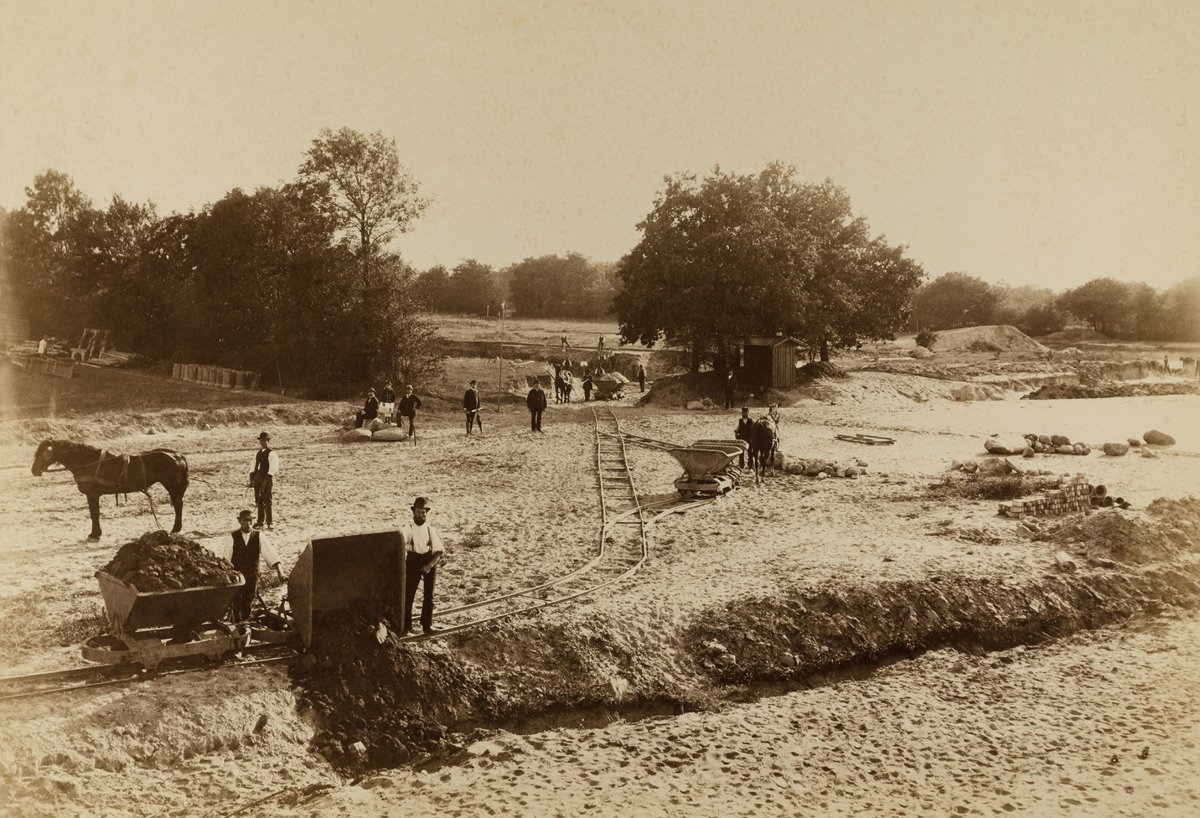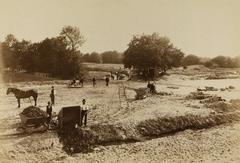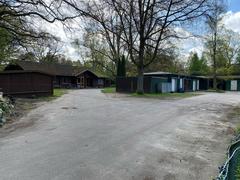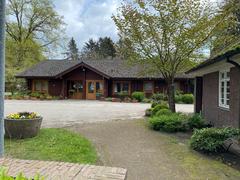
Ohlsdorf Cemetery Hamburg: Visiting Hours, Tickets, and Complete Visitor Guide
Date: 14/06/2025
Introduction: Ohlsdorf Cemetery’s History and Significance
Nestled in Hamburg’s Ohlsdorf district, Ohlsdorf Cemetery stands as the world’s largest rural cemetery, covering approximately 391 hectares (966 acres). Established in 1877 and designed by Wilhelm Cordes, this unique park cemetery seamlessly blends solemn remembrance, landscape architecture, and natural beauty. Far more than a burial ground, Ohlsdorf is a green oasis filled with historical memorials, artistic sculptures, and diverse wildlife, serving as a tranquil retreat and a vital record of Hamburg’s multifaceted cultural heritage (Hamburg Greeter; Wikipedia).
Ohlsdorf Cemetery holds profound historical significance, commemorating victims of both World Wars, Nazi persecution, and several notable individuals. Its extensive war graves include those of Allied prisoners-of-war and civilians lost during the 1943 Hamburg Firestorm air raids. Throughout the grounds, memorials honor victims from diverse backgrounds, reflecting Hamburg’s rich and complex past (Gedenkstätten in Hamburg; Find a Grave).
With more than 25,000 trees, seasonal flowers, and habitats for numerous bird species, Ohlsdorf functions as a botanical garden and wildlife sanctuary. Accessibility is excellent, with paved paths, internal bus lines, and both guided and self-guided tours available. Entry is free, making this historical and natural landmark open to all (Hamburg Travel; Friedhof Hamburg).
This detailed guide covers everything you need to know for your visit: hours, ticket information, accessibility, historical context, notable memorials, travel tips, and frequently asked questions. Whether you are drawn to the solemn memorials, artistic angel sculptures, or peaceful park-like surroundings, Ohlsdorf Cemetery offers a reflective and memorable experience (Veronika’s Adventure; Traveling Blog).
Table of Contents
- Introduction
- Origins and Development of Ohlsdorf Cemetery
- Ohlsdorf Cemetery During the World Wars
- Layout and Spatial Organization
- Natural Features and Biodiversity
- Thematic and Memorial Landscapes
- Notable Sites and Memorials
- Visiting Ohlsdorf Cemetery: Hours, Tickets, and Accessibility
- Guided Tours and Special Events
- Travel Tips and Nearby Attractions
- Visitor Experience and Practical Information
- Etiquette and Visitor Conduct
- Seasonal Considerations and Weather Tips
- Frequently Asked Questions (FAQ)
- Conclusion and Final Visitor Tips
Origins and Development of Ohlsdorf Cemetery
Founded in 1877 as a non-denominational cemetery, Ohlsdorf was created to accommodate Hamburg’s growing population and the need for a modern, inclusive burial ground outside the city center. Wilhelm Cordes’ design established a park-like landscape, fusing natural beauty with spaces for reflection (Hamburg Greeter). The cemetery features 12 chapels, over 1.5 million burials in more than 280,000 burial sites, and a network of 17 kilometers of internal roads. Its layout, with formal avenues, winding paths, water features, and wooded areas, is an exemplar of 19th-century landscape architecture (Spotting History; Isolated Traveller).
Ohlsdorf Cemetery During the World Wars
World War I
Ohlsdorf became the final resting place for over 400 Allied prisoners-of-war and sailors whose bodies were washed ashore during World War I. In 1923, British Commonwealth servicemen from 120 burial grounds in north-western Germany were reinterred here, establishing Ohlsdorf as a site of international remembrance (Spotting History).
World War II and Operation Gomorrha
The cemetery’s significance deepened during and after World War II. The Allied bombings of Hamburg in July and August 1943, known as Operation Gomorrha or the Hamburg Firestorm, killed approximately 37,000 civilians. A vast burial ground and a cross-shaped mass grave were created, with prisoners from Neuengamme concentration camp forced to recover bodies and dig graves. A monument to these victims, featuring Gerhard Marcks’ sculpture “Passage across the Styx,” stands at the grave’s intersection (Gedenkstätten in Hamburg).
Layout and Spatial Organization
Ohlsdorf Cemetery is renowned for its park-like design, with 17 kilometers of roads and paths accessible to vehicles, cyclists, and pedestrians (Hamburg Travel). Four main entrances, two internal bus lines (170 and 270 with 25 stops), and available maps make navigation feasible despite the cemetery’s vastness (Friedhof Hamburg). Distinct sections include the Old Hamburg Memorial Cemetery, the Jewish section, Commonwealth War Graves plots, family mausoleums, and 12 chapels serving various denominations (Wikipedia).
Natural Features and Biodiversity
Ohlsdorf is as much a botanical park as a burial ground, with over 25,000 trees and more than 450 species of deciduous and coniferous trees (Hamburg Travel). Its ponds, streams, and canals support aquatic life and attract waterfowl. The cemetery’s rhododendrons and rose gardens bloom vibrantly in spring and summer, while autumn brings spectacular foliage. Wildlife includes over 100 bird species, as well as squirrels, hedgehogs, rabbits, and pollinators, making it a unique ecological sanctuary in Hamburg (Famagusta Gazette).
Thematic and Memorial Landscapes
The cemetery features dedicated areas for war victims, resistance fighters, the Jewish community, and the Garden of Women. Memorials to victims of Nazi persecution, foreign forced laborers, and the Hamburg Firestorm are integrated into the landscape, offering spaces for reflection and remembrance (Wikipedia; Germany Travel Blog; Famagusta Gazette).
Notable Sites and Memorials
War Graves and Memorials
- Dutch War Cemetery: Honors Dutch victims of WWII, primarily from Neuengamme concentration camp (Find a Grave).
- Soviet War Graves: Commemorates Soviet POWs and forced laborers (Gedenkstätten in Hamburg).
- Monument to Victims of the ‘Hamburg Firestorm’: Marks the mass grave of Hamburg’s 1943 bombing victims (Gedenkstätten in Hamburg).
The Garden of Women
A unique section memorializing prominent Hamburg women, including artists, writers, and those who resisted the Nazi regime (Gedenkstätten in Hamburg).
Jewish Memorials
Includes monuments to murdered Jews from Hamburg and memorial plaques for persecuted Jewish teachers (Gedenkstätten in Hamburg).
Artistic and Symbolic Monuments
- Angel Sculptures: Iconic angel statues are central to the popular self-guided “Angel Walk,” symbolizing mourning and hope (Veronika’s Adventure).
- Heinrich Heine Monument: Honors the renowned German poet (Gedenkstätten in Hamburg).
Memorials to Resistance and Persecution
- Memorial Grove for Hamburg Resistance: Dedicated to anti-Nazi resistance fighters (Gedenkstätten in Hamburg).
- Monument to Female Opponents of the Nazi Regime: Located in the Garden of Women (Gedenkstätten in Hamburg).
Visiting Ohlsdorf Cemetery: Hours, Tickets, and Accessibility
Opening Hours
- Pedestrian and Cyclist Entrances: Daily, 7:00 am–9:00 pm
- Car Entrances:
- April–October: 9:00 am–9:00 pm
- November–March: 9:00 am–6:00 pm
- Columbaria: Follow similar seasonal schedules; may close during funeral services
- Note: Check the official website for current details and holiday changes.
Tickets and Entry
- Admission: Free; no tickets required for general access
Accessibility and Facilities
- Paths: Most main paths and memorials are wheelchair accessible; some areas may have uneven surfaces
- Internal Transport: Bus lines 170 and 270 circulate inside the cemetery, with 25 stops at key locations
- Restrooms: Located near main entrances and key points
- Visitor Center/Administration: Open weekdays; check hours before visiting
- Parking: Available near main entrances; arrive early during peak times
Guided Tours, Digital Tools, and Visitor Information
- Guided Tours: Available through local providers such as Hamburg Live Tours; focus on history, art, and notable graves
- Self-Guided Tours: The “Angel Walk” and a geo-app are available for independent exploration (Veronika’s Adventure)
- Photography: Allowed for personal use; professional photography requires permission
Travel Tips and Nearby Attractions
-
Public Transport:
- U-Bahn: U1 (direction Norderstedt) to Ohlsdorf station
- S-Bahn: S1/S11 (direction Airport/Poppenbüttel)
- From Hamburg Hauptbahnhof: ~20 minutes
- From Hamburg Airport: S1, one stop (~5 minutes)
-
Car: Fuhlsbüttler Strasse 756, 22337 Hamburg is the main navigation address
-
Nearby Sights: Combine your visit with Planten un Blomen park, the Hamburg Museum, or the historic Speicherstadt
-
Best Seasons: Spring and early summer for rhododendrons and cherry blossoms; autumn for colorful foliage
Etiquette and Visitor Conduct
- Maintain a respectful atmosphere
- Keep noise to a minimum
- Refrain from playing music
- Respect ongoing funerals and mourners
- Use discretion for photography
Seasonal Considerations and Weather Tips
- Hamburg’s weather is mild in summer and cold, damp in winter
- Dress appropriately and check forecasts
- Comfortable footwear is recommended due to the size of the grounds
Frequently Asked Questions (FAQ)
Q: What are Ohlsdorf Cemetery’s opening hours?
A: Pedestrian/cyclist entrances: 7:00 am–9:00 pm daily; car entrances vary seasonally.
Q: Is there an entrance fee?
A: No, entry is free.
Q: Are guided tours available?
A: Yes, through local providers; check availability and book in advance.
Q: Is the cemetery wheelchair accessible?
A: Most main paths and key areas are accessible; internal buses assist with mobility.
Q: Can I take photographs inside the cemetery?
A: Yes, for personal use; do not photograph mourners or ceremonies. Professional photography requires permission.
Q: Are pets allowed?
A: No, pets are not permitted to maintain a respectful environment.
Conclusion and Final Visitor Tips
Ohlsdorf Cemetery is much more than a burial ground—it is a living monument to Hamburg’s history, cultural diversity, and commitment to nature. With its expansive parklands, poignant memorials, and rich biodiversity, it offers a deeply meaningful experience for visitors seeking reflection, education, or tranquility. Its free entry, accessibility, and proximity to public transport make it an easy addition to any cultural or historical itinerary in Hamburg.
Plan your visit:
- Check the current visiting hours
- Download the geo-app for self-guided walks
- Allow several hours to explore
- Combine your trip with nearby parks or museums
For real-time updates, upcoming tours, and events, visit the official Ohlsdorf Cemetery website and follow their social media channels.
References
- Hamburg Greeter
- Wikipedia
- Gedenkstätten in Hamburg: Monument to Victims of the Hamburg Firestorm
- Friedhof Hamburg
- Hamburg Travel
- Traveling Blog
- Veronika’s Adventure
- Find a Grave
- Gedenkstätten in Hamburg: Memorials
- Hamburg Live Tours
- Famagusta Gazette























































































